Bibliometric Analysis of the Application of Soil Amendments in Improving Soil Infiltration and Storage Capacity over the Last 20 Years
Abstract
1. Introduction
2. Materials and Methods
2.1. Data Sources and Search Strategies
2.2. Data Analysis and Knowledge Graph
3. Results and Discussion
3.1. Bibliometric Review of Soil Amendments for Improving Soil Structure
3.1.1. Distribution of Publications over the Years and Major Contributing Institutions
3.1.2. International Cooperative Relations
3.1.3. Keyword Co-Occurrence Analysis
3.1.4. Keyword Emergence Analysis
3.2. Bibliometric Review of Soil Amendments for Improving Soil Hydraulic Properties
3.2.1. Distribution of Publications over the Years and Major Contributing Institutions
3.2.2. International Cooperative Relations
3.2.3. Keyword Co-Occurrence Analysis
3.2.4. Keyword Emergence Analysis
3.3. Bibliometric Review of Soil Amendments for Reducing Soil Runoff and Erosion
3.3.1. Distribution of Publications over the Years and Major Contributing Institutions
3.3.2. International Cooperative Relations
3.3.3. Keyword Co-Occurrence Analysis
3.3.4. Keyword Emergence Analysis
4. Conclusions and Prospects
- (1)
- The number of research publications on the application of soil amendments in improving soil infiltration and storage capacity during the period of 2004–2023 generally shows an upward trend. In China, research on the application of soil conditioners to improve soil structure and soil hydraulic properties is dominated by the Chinese Academy of Sciences, the Chinese Academy of Agricultural Sciences, Northwest Agriculture and Forestry University, and Shantou University, with these institutions making great contributions to this field. The USA holds the leading position in terms of research on the reduction in soil runoff and erosion, with the Agricultural Research Service, University of Arkansas, and Purdue University making the greatest contributions. China and the USA show the closest cooperation with other countries in various fields of research.
- (2)
- The current research hotspots in this field mainly include soil aggregates and aggregate stability, soil nutrients and fertility, soil microorganisms, soil pore properties, organic amendments, and biochar.
- (3)
- Future research should focus on studying the long-term effects of porous materials, including biochar, on the productivity of reclaimed soils and the growth of crops when used as soil amendments to improve soil infiltration and storage capacity. Additionally, future research should further explore the effects of the interactions between soil aggregates and surface runoff, particularly the processes of aggregate dispersion, transportation, and deposition during rainfall erosion, and clarify the key factors affecting their changes.
Author Contributions
Funding
Institutional Review Board Statement
Data Availability Statement
Conflicts of Interest
References
- Sun, J.N.; Yang, R.Y.; Li, W.X.; Pan, Y.H.; Zheng, M.Z.; Zhang, Z.H. Effect of biochar amendment on water infiltration in a coastal saline soil. J. Soils Sediments 2018, 18, 3271–3279. [Google Scholar] [CrossRef]
- Abrol, V.; Ben-Hur, M.; Verheijen, F.G.A.; Keizer, J.J.; Martins, M.A.S.; Tenaw, H.; Tchehansky, L.; Graber, E.R. Biochar effects on soil water infiltration and erosion under seal formation conditions: Rainfall simulation experiment. J. Soils Sediments 2016, 16, 2709–2719. [Google Scholar] [CrossRef]
- Alshraah, S.H.; Kranz, C.N.; McLaughlin, R.A.; Heitman, J.L. Wildflowers and compost amendment can improve infiltration in soils impacted by construction. J. Am. Water Resour. Assoc. 2024, 60, 784–795. [Google Scholar] [CrossRef]
- Mujdeci, M.; Simsek, S.; Uygur, V. The effects of organic amendments on soil water retention characteristics under conventional tillage system. Fresenius Environ. Bull. 2017, 26, 4075–4081. [Google Scholar]
- Demir, Y.; Demir, A.D. The effect of organic matter applications on the saturated hydraulic conductivity and available water-holding capacity of sandy soils. Appl. Ecol. Environ. Res. 2019, 17, 3137–3146. [Google Scholar] [CrossRef]
- Yang, Y.H.; Wu, J.C.; Zhao, S.W.; Han, Q.Y.; Pan, X.Y.; He, F.; Chen, C. Assessment of the responses of soil pore properties to combined soil structure amendments using X-ray computed tomography. Sci. Rep. 2018, 8, 695. [Google Scholar] [CrossRef]
- Gabioud, E.A.; Sasal, M.C.; Wilson, M.G.; Seehaus, M.S.; Van Opstal, N.V.; Beghetto, S.M.; Wingeyer, A.B. Addition of organic and inorganic amendments to regenerate the surface structure of silty soils. Soil Use Manag. 2020, 36, 449–458. [Google Scholar]
- Wu, S.F.; Wu, P.T.; Feng, H.; Bu, C.F. Influence of amendments on soil structure and soil loss under simulated rainfall China’s loess plateau. Afr. J. Biotechnol. 2010, 9, 6116–6121. [Google Scholar]
- Ouyang, L.; Wang, F.; Tang, J.; Yu, L.; Zhang, R. Effects of biochar amendment on soil aggregates and hydraulic properties. J. Soil Sci. Plant Nutr. 2013, 13, 991–1002. [Google Scholar] [CrossRef]
- Niaz, S.; Wehr, J.B.; Dalal, R.C.; Kopittke, P.M.; Menzies, N.W. Wetting and drying cycles, organic amendments, and gypsum play a key role in structure formation and stability of sodic Vertisols. SOIL 2023, 9, 141–154. [Google Scholar] [CrossRef]
- Vargas, G.; Verdejo, J.; Rivera, A.; Suárez, D.; Youlton, C.; Celis-Diez, J.L.; Le Bissonnais, Y.; Dovletyarova, E.A.; Neaman, A. The effect of four calcium-based amendments on soil aggregate stability of two sandy topsoils. J. Plant Nutr. Soil Sci. 2019, 182, 159–166. [Google Scholar] [CrossRef]
- Duan, C.X.; Chen, J.F.; Li, J.B.; Feng, H.; Wu, S.F.; Meng, Q.T.; Siddique, K.H.M. Effects of organic amendments and ridge-furrow mulching system on soil properties and economic benefits of wolfberry orchards on the Tibetan Plateau. Sci. Total Environ. 2022, 827, 154317. [Google Scholar] [CrossRef] [PubMed]
- García-Orenes, F.; Guerrero, C.; Mataix-Solera, J.; Navarro-Pedreño, J.; Gómez, I.; Mataix-Beneyto, J. Factors controlling the aggregate stability and bulk density in two different degraded soils amended with biosolids. Soil Tillage Res. 2005, 82, 65–76. [Google Scholar] [CrossRef]
- Manirakiza, N.; Seker, C. Effects of compost and biochar amendments on soil fertility and crop growth in a calcareous soil. J. Plant Nutr. 2020, 43, 3002–3019. [Google Scholar] [CrossRef]
- Zhou, H.X.; Yu, X.L.; Chen, C.; Zeng, L.Z.; Lu, S.G.; Wu, L.S. Evaluating Hydraulic Properties of Biochar-Amended Soil Aggregates by High-Performance Pore-Scale Simulations. Soil Sci. Soc. Am. J. 2018, 82, 1–9. [Google Scholar] [CrossRef]
- Tuyishimire, E.; Cui, J.F.; Tang, X.Y.; Sun, Z.X.; Cheng, J.H. Interactive Effects of Honeysuckle Planting and Biochar Amendment on Soil Structure and Hydraulic Properties of Hillslope Farmland. Agriculture 2022, 12, 414. [Google Scholar] [CrossRef]
- Rasa, K.; Tähtikarhu, M.; Miettinen, A.; Kähärä, T.; Uusitalo, R.; Mikkola, J.; Hyväluoma, J. A large one-time addition of organic soil amendments increased soil macroporosity but did not affect intra-aggregate porosity of a clay soil. Soil Tillage Res. 2024, 242, 106139. [Google Scholar] [CrossRef]
- Fei, Y.H.; She, D.L.; Gao, L.; Xin, P. Micro-CT assessment on the soil structure and hydraulic characteristics of saline/sodic soils subjected to short-term amendment. Soil Tillage Res. 2019, 193, 59–70. [Google Scholar] [CrossRef]
- Sun, X.Q.; She, D.L.; Fei, Y.H.; Wang, H.D.; Gao, L. Three-dimensional fractal characteristics of soil pore structure and their relationships with hydraulic parameters in biochar-amended saline soil. Soil Tillage Res. 2021, 205, 104809. [Google Scholar]
- Hussain, R.; Ravi, K. Investigating unsaturated hydraulic conductivity and water retention characteristics of compacted biochar-amended soils for potential application in bioengineered structures. J. Hydrol. 2021, 603, 127040. [Google Scholar] [CrossRef]
- Xuan, K.F.; Li, X.P.; Yu, X.L.; Jiang, Y.F.; Ji, J.C.; Jia, R.H.; Wang, C.; Liu, J.L. Effects of different organic amendments on soil pore structure acquired by three-dimensional investigation. Eur. J. Soil Sci. 2022, 73, e13264. [Google Scholar]
- Abd El-Halim, A.A.; Kumlung, A. Modification of sandy soil hydrophysical environment through bagasse additive under laboratory experiment. Int. Agrophys 2015, 29, 101–106. [Google Scholar]
- Li, X.X.; Chen, X.B.; Weber-Siwirska, M.; Cao, J.J.; Wang, Z.L. Effects of rice-husk biochar on sand-based rootzone amendment and creeping bentgrass growth. Urban For. Urban Green. 2018, 35, 165–173. [Google Scholar] [CrossRef]
- Chen, X.P.; Duan, M.L.; Zhou, B.B.; Cui, L. Effects of biochar nanoparticles as a soil amendment on the structure and hydraulic characteristics of a sandy loam soil. Soil Use Manag. 2022, 38, 836–849. [Google Scholar]
- Githinji, L. Effect of biochar application rate on soil physical and hydraulic properties of a sandy loam. Arch. Agron. Soil Sci. 2014, 60, 457–470. [Google Scholar] [CrossRef]
- Garg, A.; Zhu, H.H.; Sarmah, A.K.; Mei, G.X.; Gadi, V.K. Evaluating mechanism and inconsistencies in hydraulic conductivity of unsaturated soil using newly proposed biochar conductivity factor. Biochar 2023, 5, 34. [Google Scholar]
- Chen, Z.K.; Kamchoom, V.; Chen, R.; Prasittisopin, L. Investigating the impacts of biochar amendment and soil compaction on unsaturated hydraulic properties of silty sand. Agronomy 2023, 13, 1845. [Google Scholar] [CrossRef]
- Abraha, A.B.; Tesfamariam, E.H.; Truter, W.F. Can a blend of amendments be an important component of a rehabilitation strategy for surface coal mined soils? Sustainability 2019, 11, 4297. [Google Scholar] [CrossRef]
- Wanniarachchi, D.; Cheema, M.; Thomas, R.; Kavanagh, V.; Galagedara, L. Impact of soil amendments on the hydraulic conductivity of boreal agricultural podzols. Agriculture 2019, 9, 133. [Google Scholar] [CrossRef]
- Ma, R.; Tian, Z.Y.; Wang, M.Y.; Zhu, X.C.; He, Y.Z.; Shi, X.Z.; Liang, Y. Effects of organic amendments on soil hydraulic characteristics in the Mollisols of Northeast China. Land Degrad. Dev. 2023, 34, 5401–5415. [Google Scholar]
- Mohawesh, O.; Durner, W. Effects of Bentonite, Hydrogel and Biochar Amendments on Soil Hydraulic Properties from Saturation to Oven Dryness. Pedosphere 2019, 29, 598–607. [Google Scholar]
- Alghamdi, A.G.; Aly, A.A.; Al-Omran, A.M.; Alkhasha, A. Impact of biochar, bentonite, and compost on physical and chemical characteristics of a sandy soil. Arab. J. Geosci. 2018, 11, 670. [Google Scholar]
- Sadeghi, S.H.R.; Moghadam, E.S.; Darvishan, A.K. Effects of subsequent rainfall events on runoff and soil erosion components from small plots treated by vinasse. Catena 2016, 138, 1–12. [Google Scholar]
- Huang, X.L.; Niu, R.J.; Huang, X.L.; An, Y.X.; Li, J.H.; Li, M.Q.; Huang, H.; Garg, A. Influence of Sustainable Biochars Produced from Kitchen Waste, Pig Manure, and Wood on Soil Erosion. Water 2021, 13, 2296. [Google Scholar] [CrossRef]
- Rhoton, F.E.; McChesney, D.S. Erodibility of a sodic soil amended with flue gas desulfurization gypsum. Soil Sci. 2011, 176, 190–195. [Google Scholar]
- Cochrane, B.H.W.; Reichert, J.M.; Eltz, F.L.F.; Norton, L.D. Controlling soil erosion and runoff with polyacrylamide and phosphogypsum on subtropical soil. Trans. ASAE 2005, 48, 149–154. [Google Scholar]
- Yang, Y.H.; Zhang, S.S.; Wu, J.C.; Gao, C.M.; Lu, D.F.; Tang, D.W.S. Effect of long term application of super absorbent polymer on soil structure, soil enzyme activity, photosynthetic characteristics, water and nitrogen use of winter wheat. Front. Plant Sci. 2022, 13, 998494. [Google Scholar]
- Han, Y.; Zhang, J.Z.; Chen, P.P.; Li, H.Q.; Li, W.H.; Liu, J.; Zong, R.; Wang, D.W.; Liang, Y.H.; Wang, Z.H. Biochar improves water and nitrogen use efficiency of cotton under mulched drip irrigation in arid regions. Ind. Crops Prod. 2024, 222, 119830. [Google Scholar]
- Mi, J.Z.; Gregorich, E.G.; Xu, S.T.; McLaughlin, N.B.; Ma, B.; Li, J.H. Effect of bentonite amendment on soil hydraulic parameters and millet crop performance in a semi-arid region. Field Crops Res. 2017, 212, 107–114. [Google Scholar]
- Matisic, M.; Dugan, I.; Bogunovic, I. Challenges in sustainable agriculture-the role of organic amendments. Agriculture 2024, 14, 643. [Google Scholar] [CrossRef]
- Adjuik, T.A.; Nokes, S.E.; Montross, M.D.; Wendroth, O. The impacts of bio-based and synthetic hydrogels on soil hydraulic properties: A Review. Polymers 2022, 14, 4721. [Google Scholar] [CrossRef] [PubMed]
- Ahmed, A.; Kurian, J.; Raghavan, V. Biochar influences on agricultural soils, crop production, and the environment: A review. Environ. Rev. 2016, 24, 495–502. [Google Scholar] [CrossRef]
- Pan, X.Y.; Lv, J.L.; Dyck, M.; He, H.L. Bibliometric Analysis of Soil Nutrient Research between 1992 and 2020. Agriculture 2021, 11, 223. [Google Scholar] [CrossRef]
- Ma, X.X.; Pan, J.; Xue, X.; Zhang, J.; Guo, Q. A Bibliometric review of plant growth-promoting rhizobacteria in salt-affected soils. Agronomy 2022, 12, 2304. [Google Scholar] [CrossRef]
- Razzaghi, F.; Obour, P.B.; Arthur, E. Does biochar improve soil water retention? A systematic review and meta-analysis. Geoderma 2020, 36, 114055. [Google Scholar]
- Khan, K.S.; Joergensen, R.G. Microbial C, N, and P relationships in moisture-stressed soils of Potohar, Pakistan. J. Plant Nutr. Soil Sci. 2006, 169, 494–500. [Google Scholar]
- Gichangi, E.M.; Mnkeni, P.N.S.; Brookes, P.C. Effects of goat manure and inorganic phosphate addition on soil inorganic and microbial biomass phosphorus fractions under laboratory incubation conditions. Soil Sci. Plant Nutr. 2009, 55, 764–771. [Google Scholar]
- Heyman, H.; Bassuk, N.; Bonhotal, J.; Walter, T. Compost quality recommendations for remediating urban soils. Int. J. Environ. Res. Public Health 2019, 16, 3191. [Google Scholar] [CrossRef]
- Yu, H.W.; Zou, W.X.; Chen, J.J.; Chen, H.; Yu, Z.B.; Huang, J.; Tang, H.R.; Wei, X.Y.; Gao, B. Biochar amendment improves crop production in problem soils: A review. J. Environ. Manag. 2019, 232, 8–21. [Google Scholar]
- Suthar, R.G.; Wang, C.; Nunes, M.C.N.; Chen, J.J.; Sargent, S.A.; Bucklin, R.A.; Gao, B. Bamboo biochar pyrolyzed at low temperature improves tomato plant growth and fruit quality. Agriculture 2018, 8, 153. [Google Scholar] [CrossRef]
- Obour, A.K.; Mikha, M.M.; Holman, J.D.; Stahlman, P.W. Changes in soil surface chemistry after fifty years of tillage and nitrogen fertilization. Geoderma 2017, 308, 46–53. [Google Scholar] [CrossRef]
- Jia, L.Z.; Zhao, W.W.; Zhai, R.J.; Liu, Y.; Kang, M.M.; Zhang, X. Regional differences in the soil and water conservation efficiency of conservation tillage in China. Catena 2019, 175, 18–26. [Google Scholar] [CrossRef]
- Ul Islam, M.; Jiang, F.H.; Guo, Z.C.; Peng, X.H. Does biochar application improve soil aggregation? A meta-analysis. Soil Tillage Res. 2021, 209, 104926. [Google Scholar] [CrossRef]
- Cai, W.L.; Huang, H.; Chen, P.N.; Huang, X.L.; Gaurav, S.; Pan, Z.; Lin, P. Effects of biochar from invasive weed on soil erosion under varying compaction and slope conditions: Comprehensive study using flume experiments. Biomass Convers. Biorefin 2024, 14, 5771–5790. [Google Scholar]
- Soinne, H.; Hovi, J.; Tammeorg, P.; Turtola, E. Effect of biochar on phosphorus sorption and clay soil aggregate stability. Geoderma 2014, 219, 162–167. [Google Scholar] [CrossRef]
- Sun, Q.; Meng, J.; Lan, Y.; Shi, G.H.; Yang, X.; Cao, D.A.Y.; Chen, W.F.; Han, X.R. Long-term effects of biochar amendment on soil aggregate stability and biological binding agents in brown earth. Catena 2021, 205, 105460. [Google Scholar]
- Wiersma, W.; Van der Ploeg, M.J.; Sauren, I.J.; Stoof, C.R. No effect of pyrolysis temperature and feedstock type on hydraulic properties of biochar and amended sandy soil. Geoderma 2020, 364, 114209. [Google Scholar]
- Alghamdi, A.G.; Al-Omran, A.; Alkhasha, A.; Alasmary, Z.; Aly, A.A. Significance of pyrolytic temperature, particle size, and application rate of biochar in improving hydro-physical properties of calcareous sandy soil. Agriculture 2021, 11, 1293. [Google Scholar] [CrossRef]
- Esmaeelnejad, L.; Shorafa, M.; Gorji, M.; Hosseini, S.M. Impacts of woody biochar particle size on porosity and hydraulic conductivity of biochar-soil mixtures: An incubation study. Commun. Soil Sci. Plant Anal. 2017, 48, 1710–1718. [Google Scholar]
- Alghamdi, A.G.; Alkhasha, A.; Ibrahim, H.M. Effect of biochar particle size on water retention and availability in a sandy loam soil. J. Saudi Chem. Soc. 2020, 24, 1042–1050. [Google Scholar]
- Obour, P.B.; Danso, E.O.; Pouladi, N.; Abenney-Mickson, S.; Sabi, E.B.; Monnie, F.; Arthur, E. Soil structure characteristics, functional properties and consistency limits response to corn cob biochar particle size and application rates in a 36-month pot experiment. Soil Res. 2020, 58, 488–497. [Google Scholar]
- Edeh, I.G.; Masek, O. The role of biochar particle size and hydrophobicity in improving soil hydraulic properties. Eur. J. Soil Sci. 2022, 73, e13138. [Google Scholar] [CrossRef]
- Liu, J.J.; Lu, S.G. Amendment of different biochars changed pore characteristics and permeability of Ultisol macroaggregates identified by X-ray computed tomography (CT). Geoderma 2023, 434, 116470. [Google Scholar]
- Shi, P.; Arter, C.; Liu, X.Y.; Keller, M.; Schulin, R. Soil aggregate stability and size-selective sediment transport with surface runoff as affected by organic residue amendment. Sci. Total Environ. 2017, 607, 95–102. [Google Scholar]
- Chen, Y.J.; Day, S.D.; Wick, A.F.; McGuire, K.J. Influence of urban land development and subsequent soil rehabilitation on soil aggregates, carbon, and hydraulic conductivity. Sci. Total Environ. 2014, 494, 329–336. [Google Scholar]
- Cogger, C.G. Potential compost benefits for restoration of soils disturbed by urban development. Compost. Sci. Util. 2005, 13, 243–251. [Google Scholar]
- Bodner, G.; Leitner, D.; Kaul, H.P. Coarse and fine root plants affect pore size distributions differently. Plant Soil. 2014, 380, 133–151. [Google Scholar] [CrossRef]
- Makó, A.; Barna, G.; Horel, A. Soil physical properties affected by biochar addition at different plant phaenological phases. Part II. Int. Agrophysics 2020, 34, 1–7. [Google Scholar]
- Mau, V.; Arye, G.; Gross, A. Poultry litter hydrochar as an amendment for sandy soils. J. Environ. Manag. 2020, 271, 110959. [Google Scholar] [CrossRef]
- Blanco-Canqui, H. Does biochar application alleviate soil compaction? Review and data synthesis. Geoderma 2021, 404, 115317. [Google Scholar]
- Kok, D.J.D.; Scherer, L.; de Vries, W.; van Bodegom, P.M. Temporal variability in organic amendment impacts on hydro-physical properties of sandy agricultural soils. Soil Sci. Soc. Am. J. 2023, 87, 963–984. [Google Scholar]
- Chen, Y.M.; Xu, X.; Jiao, X.G.; Sui, Y.Y.; Liu, X.B.; Zhang, J.Y.; Zhou, K.; Zhang, J.M. Responses of labile organic nitrogen fractions and enzyme activities in eroded mollisols After 8-year manure amendment. Sci. Rep. 2018, 8, 14179. [Google Scholar] [CrossRef] [PubMed]
- Shi, P.; Schulin, R. Erosion-induced losses of carbon, nitrogen, phosphorus and heavy metals from agricultural soils of contrasting organic matter management. Sci. Total. Environ. 2018, 618, 210–218. [Google Scholar] [PubMed]
- Rasa, K.; Tähtikarhu, M.; Miettinen, A.; Kähärä, T.; Uusitalo, R.; Mikkola, J.; Hyväluoma, J. Pulp and paper mill sludges decrease soil erodibility. J. Environ. Qual. 2021, 50, 172–184. [Google Scholar]
- Gholami, L.; Sadeghi, S.H.R.; Homaee, M. Different effects of sheep manure conditioner on runoff and soil loss components in eroded soil. Catena 2016, 139, 99–104. [Google Scholar]
- Zougmoré, R.; Mando, A.; Stroosnijder, L. Soil nutrient and sediment loss as affected by Erosion barriers and nutrient source in semi-arid Burkina Faso. Arid. Land Res. Manag. 2009, 23, 85–101. [Google Scholar]
- Baptista, I.; Ritsema, C.; Geissen, V. Effect of integrated water-nutrient management strategies on soil erosion mediated nutrient loss and crop productivity in cabo verde drylands. PLoS ONE 2015, 10, e0134244. [Google Scholar]
- Pinardi, M.; Soana, E.; Severini, E.; Racchetti, E.; Celico, F.; Bartoli, M. Agricultural practices regulate the seasonality of groundwater-river nitrogen exchanges. Agric. Water Manag. 2022, 273, 107904. [Google Scholar]
- Zhao, X.L.; Mak-Mensah, E.; Zhao, W.C.; Wang, Q.; Zhou, X.J.; Zhang, D.K.; Zhu, J.H.; Qi, W.J.; Liu, Q.L.; Li, X.L.; et al. Optimized ridge-furrow technology with biochar amendment for alfalfa yield enhancement and soil erosion reduction based on a structural equation model on sloping land. Agric. Water Manag. 2024, 298, 108866. [Google Scholar]
- Rens, H.; Bera, T.; Alva, A.K. Effects of biochar and biosolid on adsorption of nitrogen, phosphorus, and potassium in two soils. Water Air Soil Pollut. 2018, 229, 281. [Google Scholar]
- Vanwalleghem, T.; Gomez, J.A.; Amate, J.I.; de Molina, M.G.; Vanderlinden, K.; Guzman, G.; Laguna, A.; Giraldez, J.V. Impact of historical land use and soil management change on soil erosion and agricultural sustainability during the Anthropocene. Anthropocene 2017, 17, 13–29. [Google Scholar] [CrossRef]
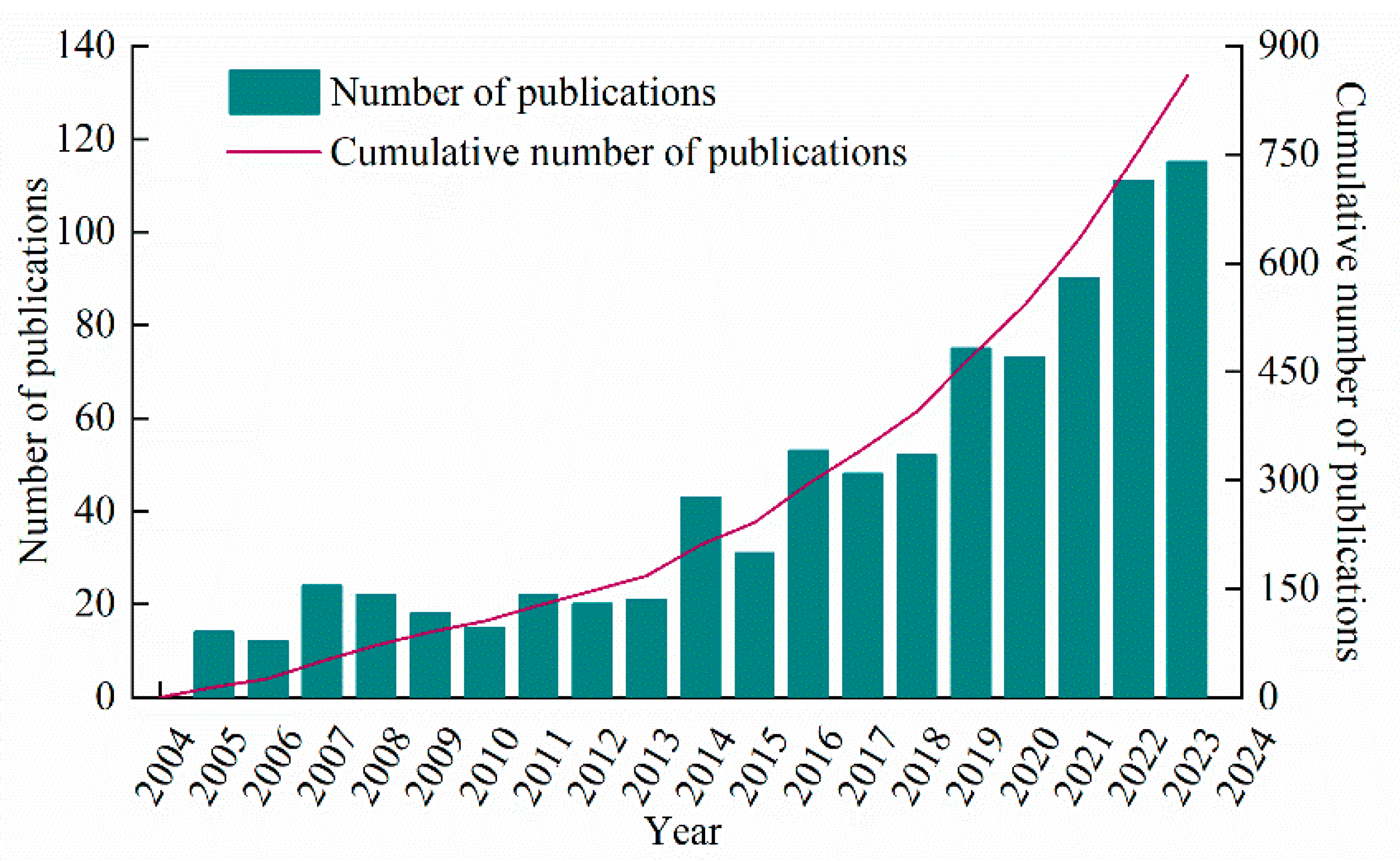
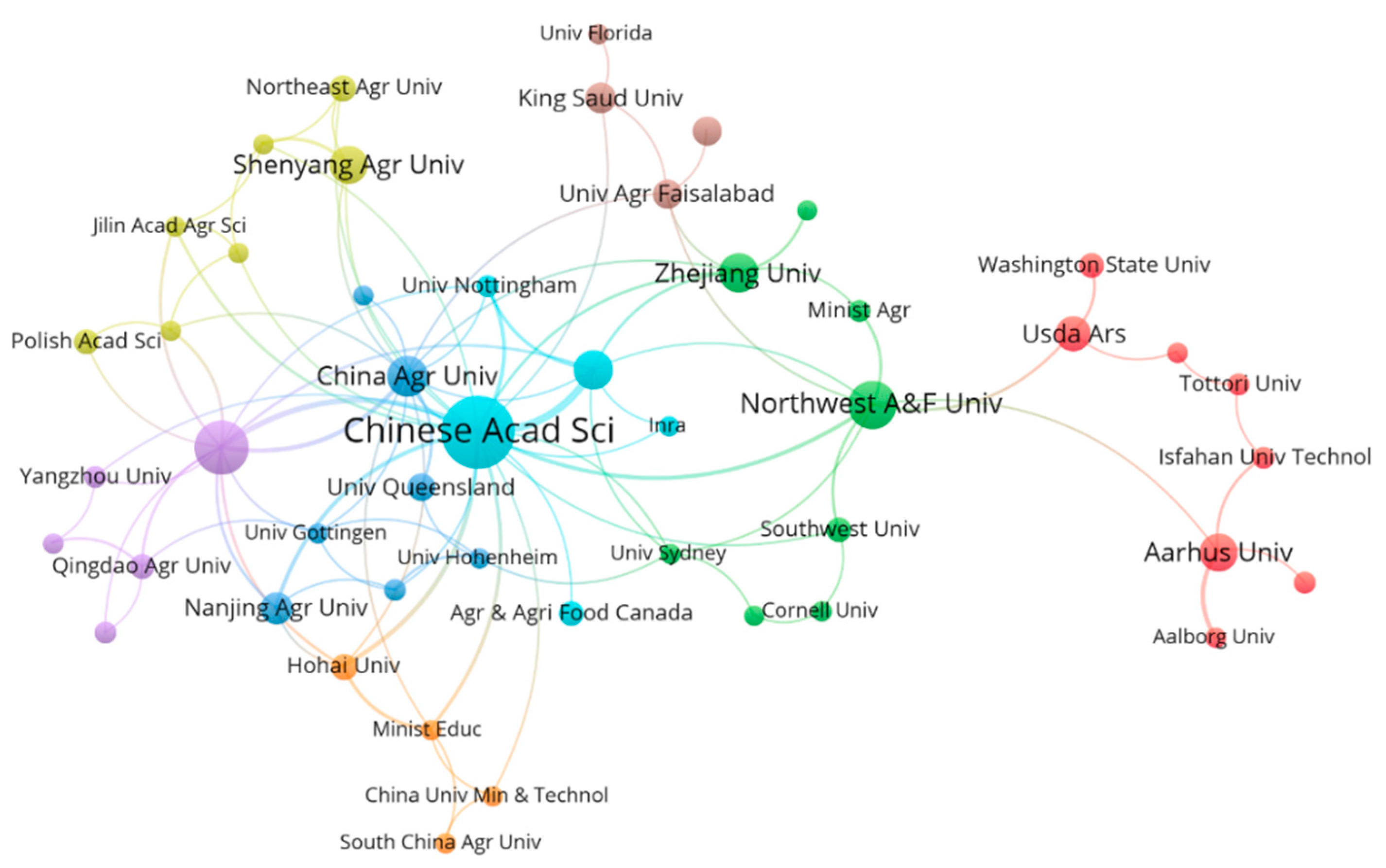
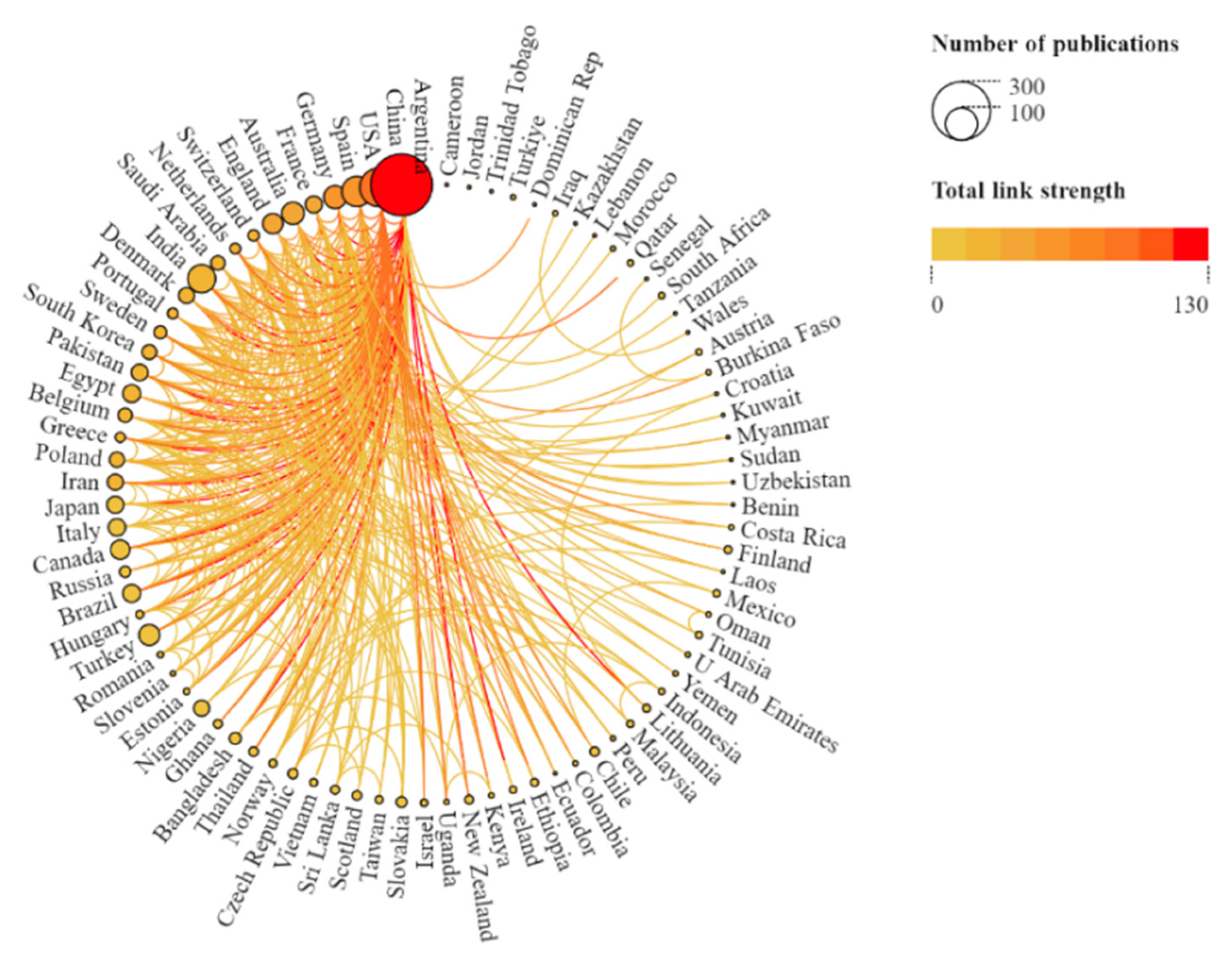
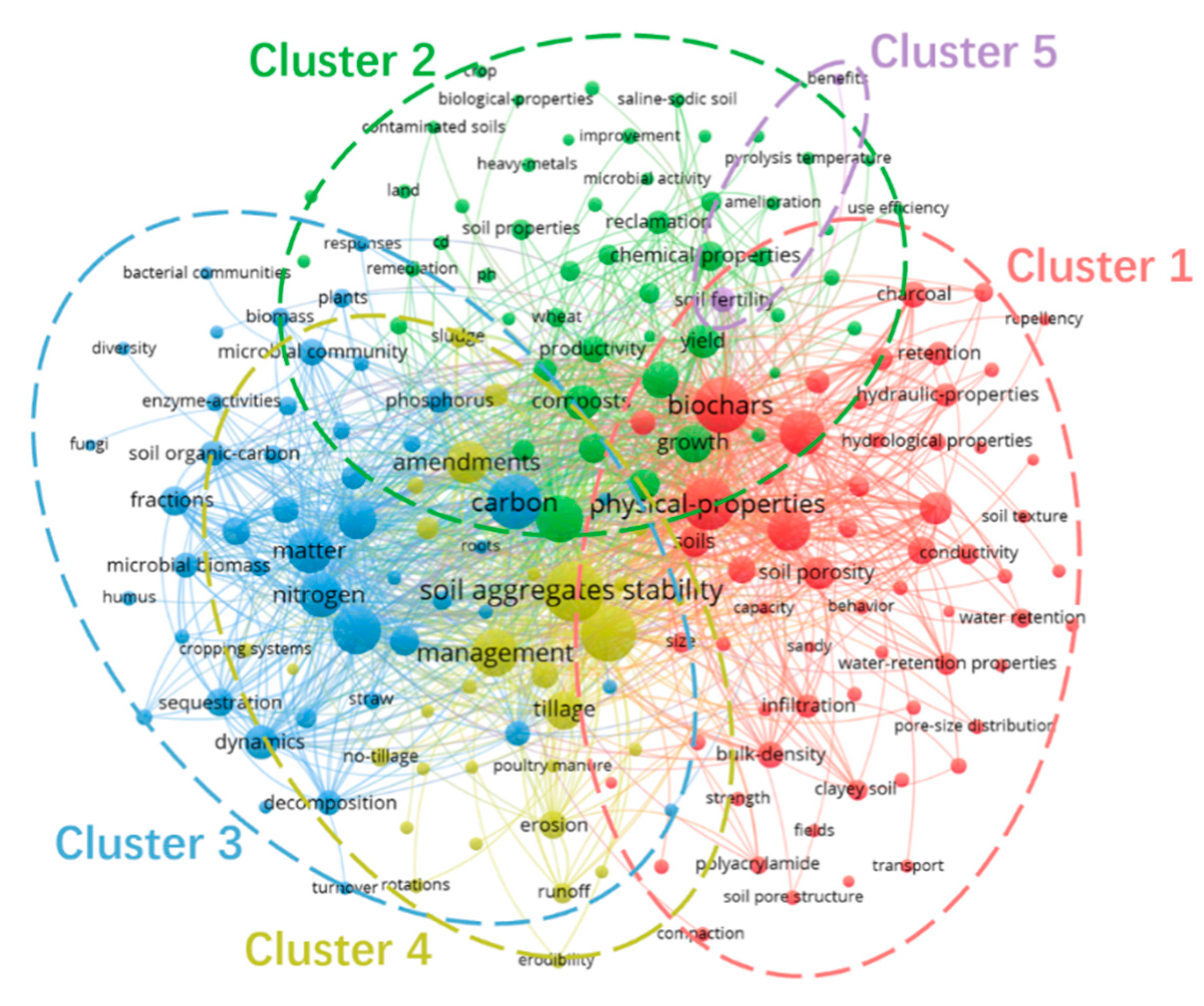
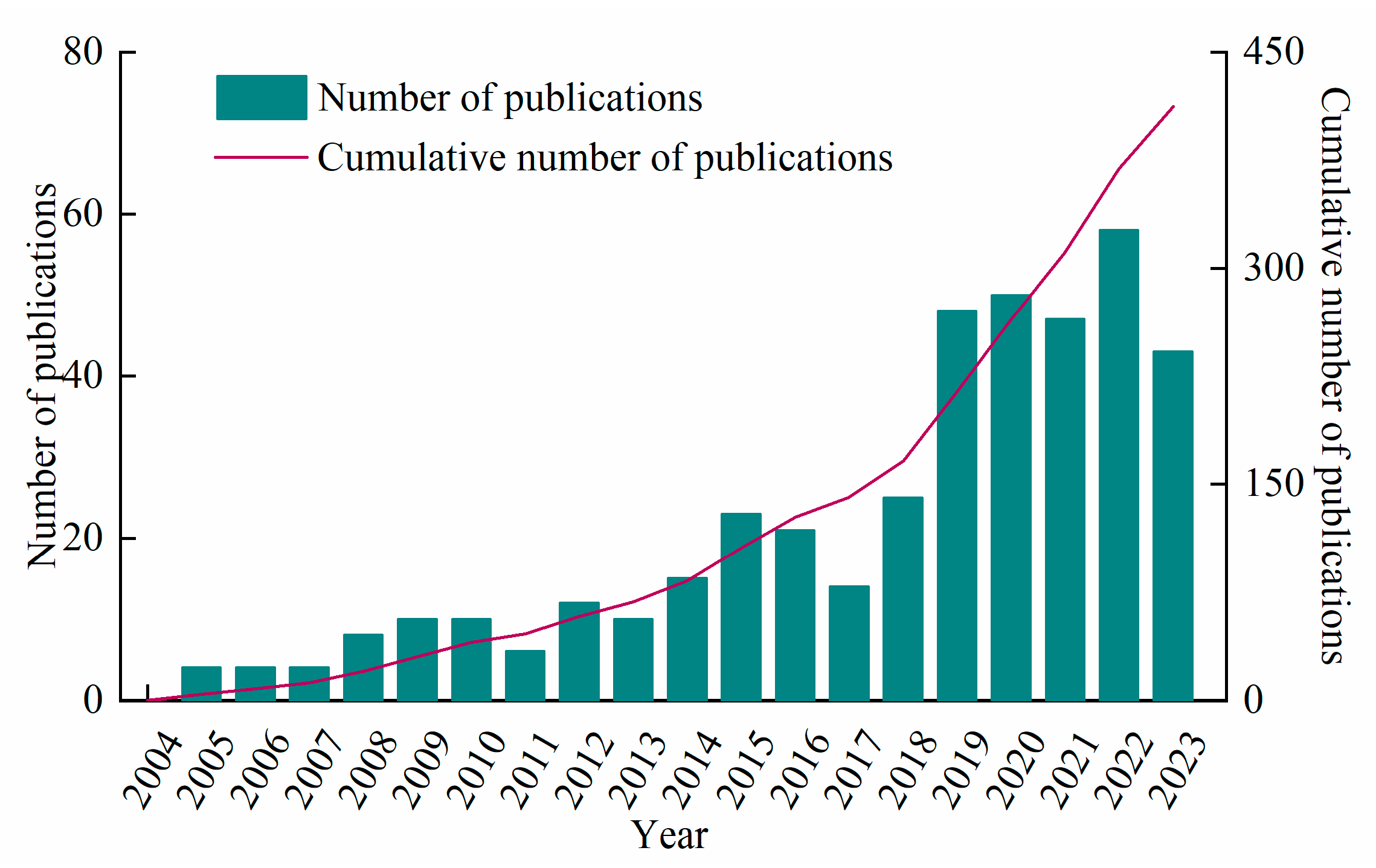
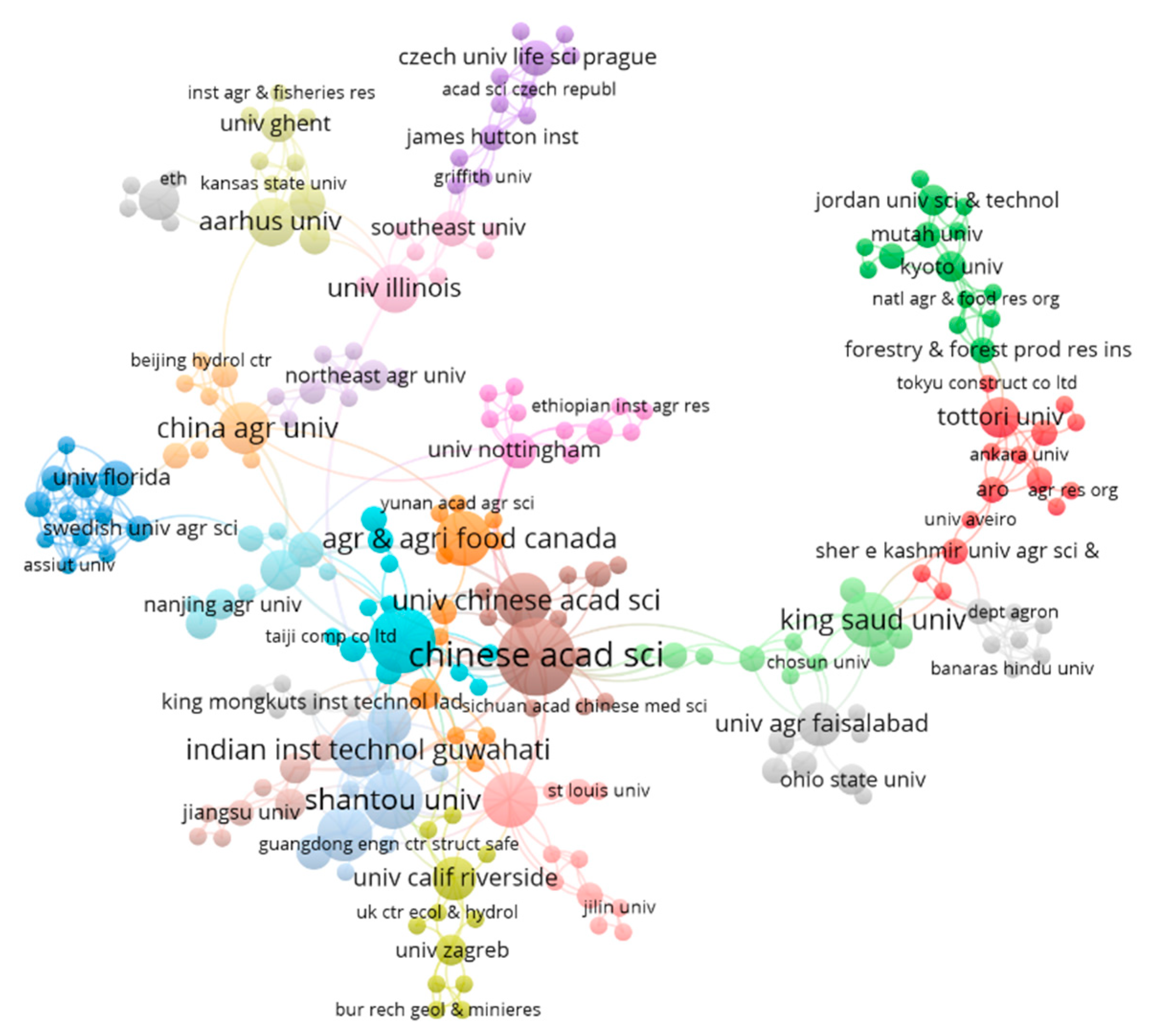

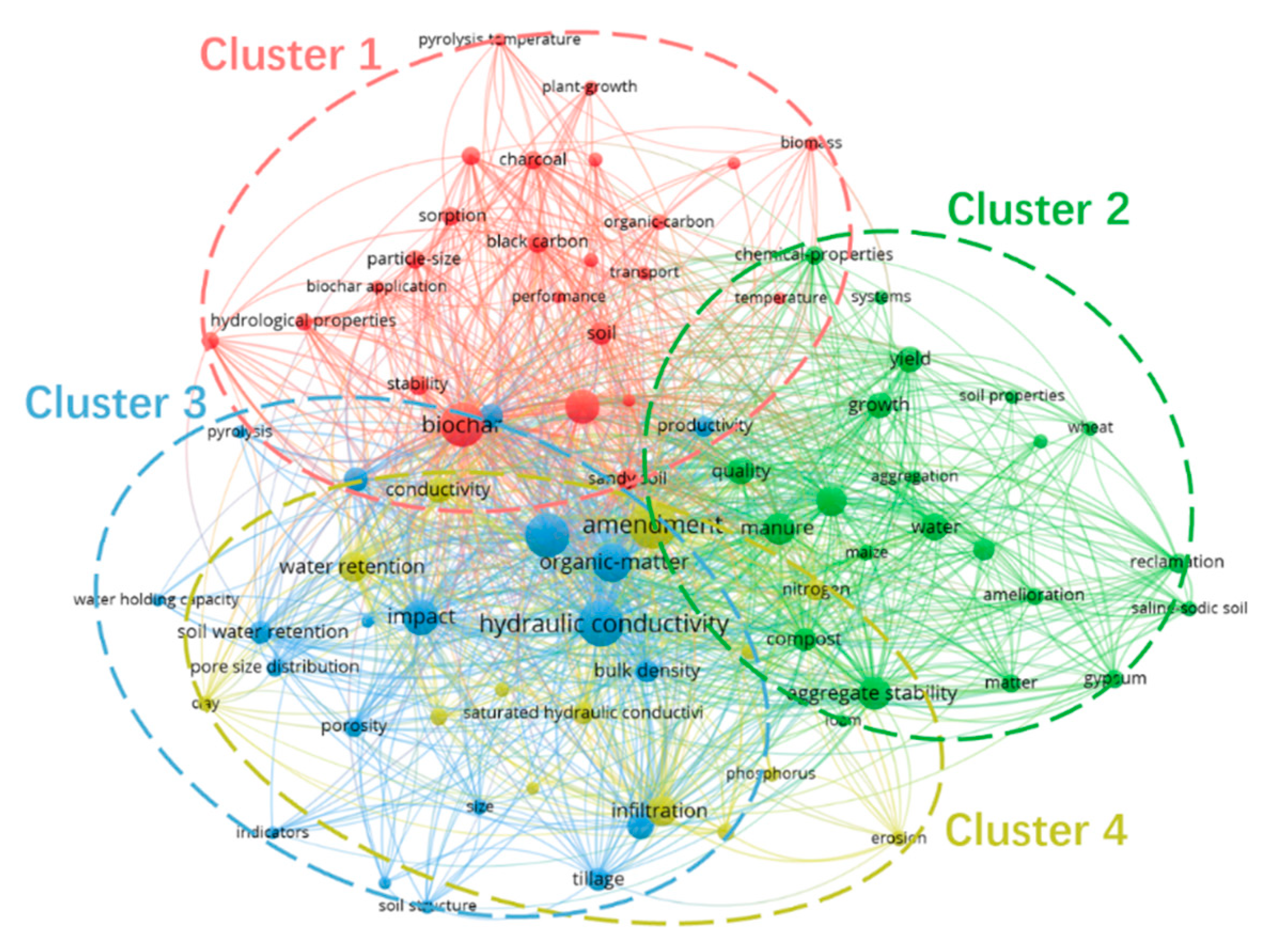
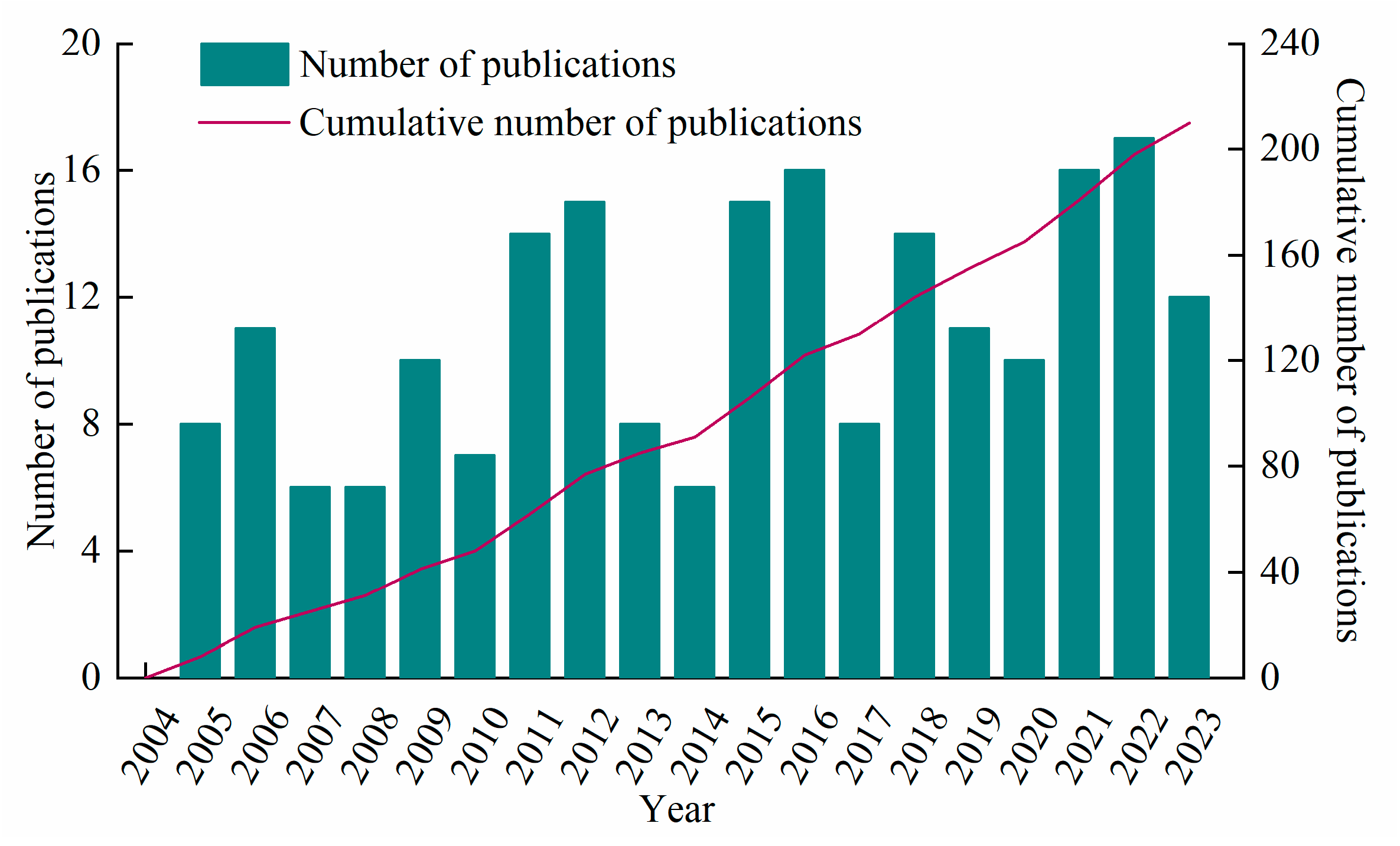
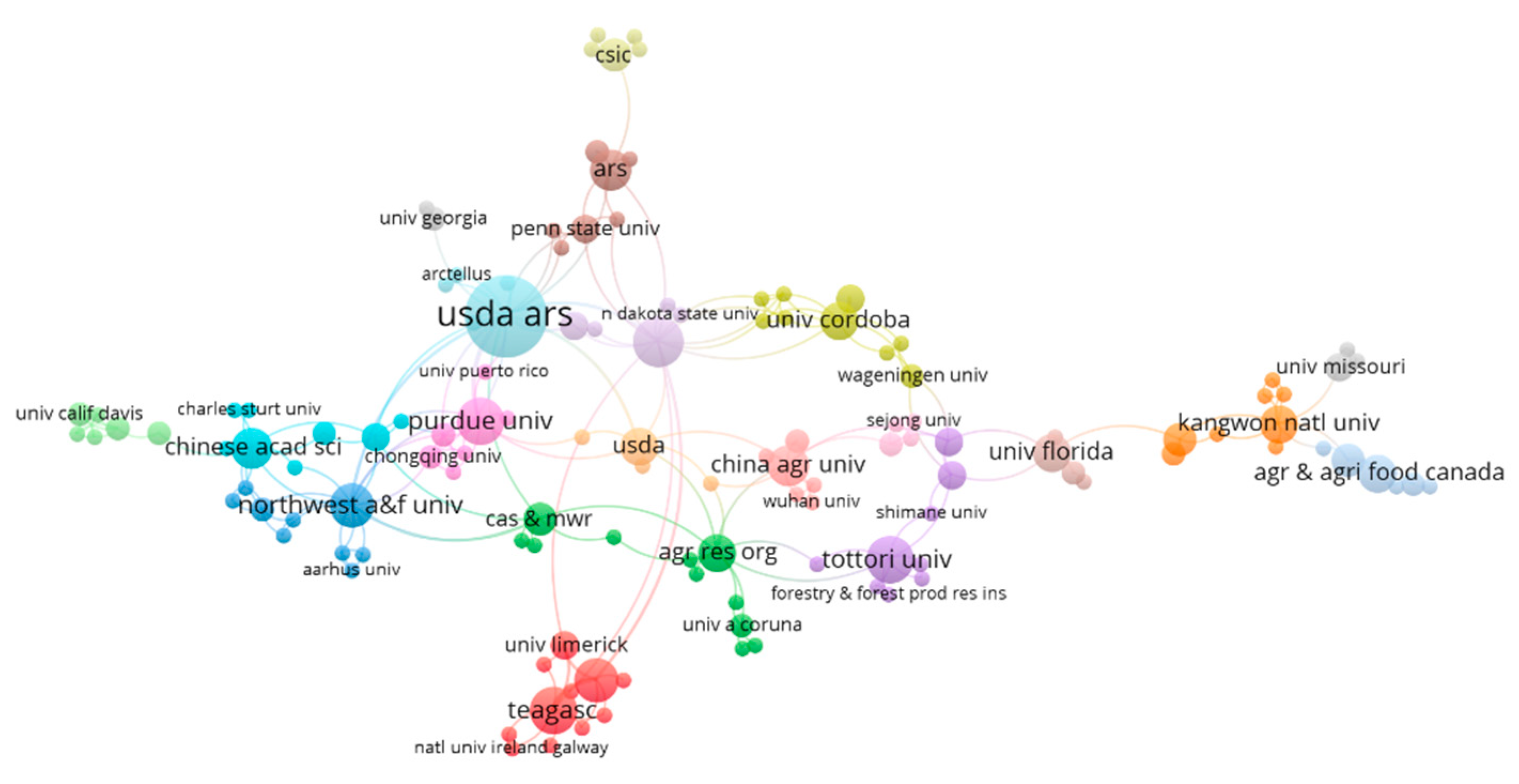
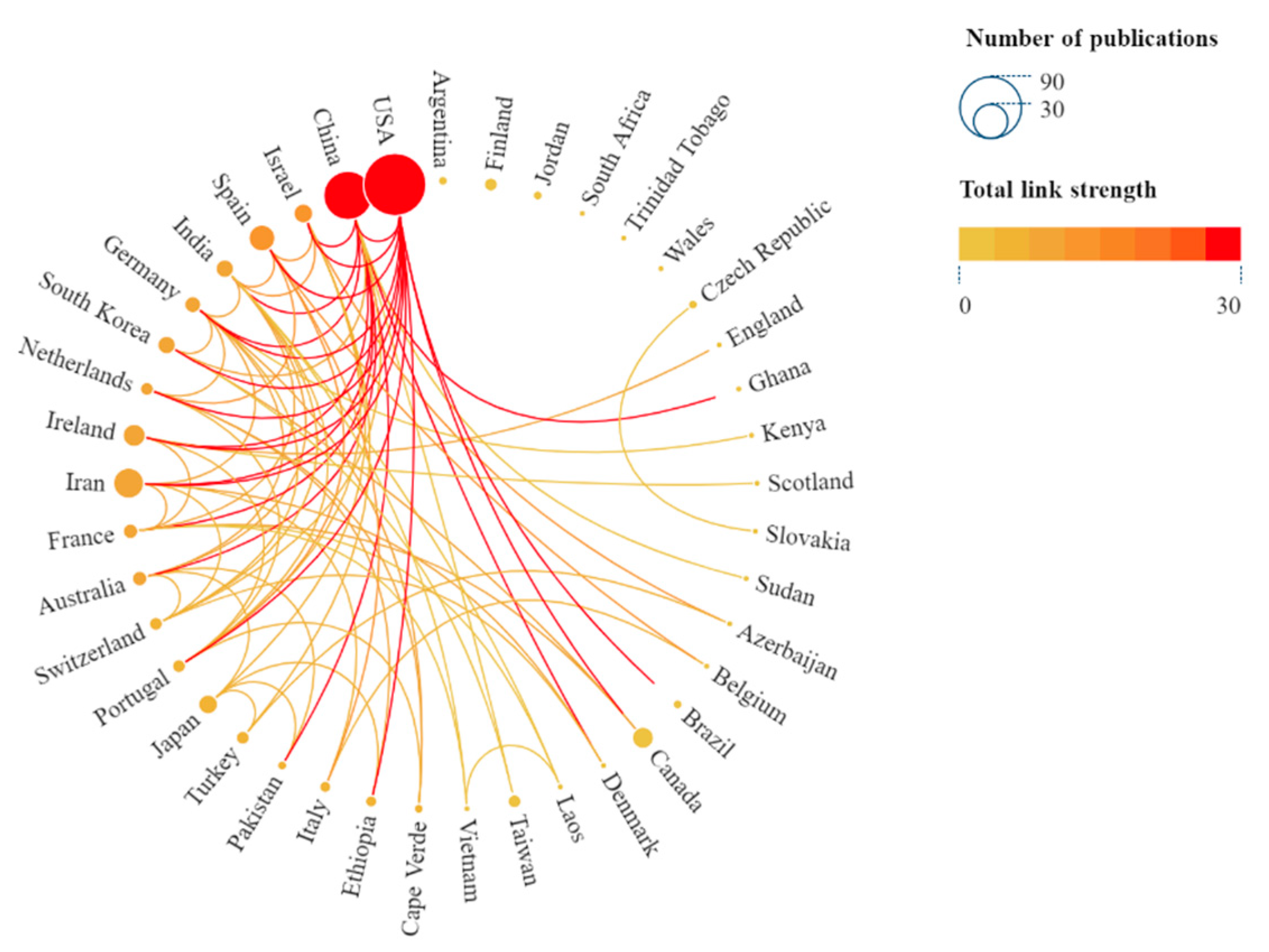
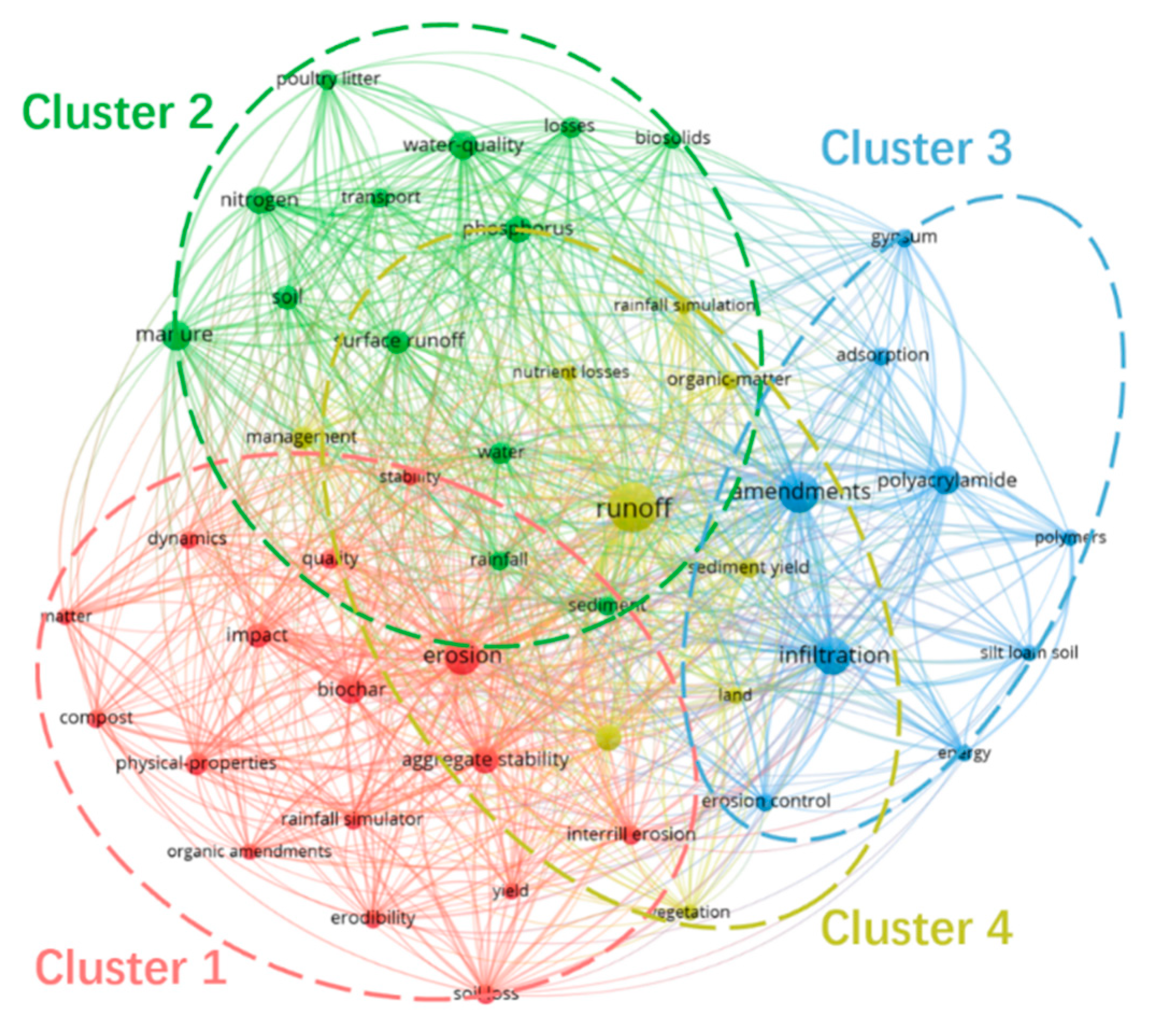
| Keywords | Strength | Begin | End | 2004–2023 |
|---|---|---|---|---|
| compost | 6.12 | 2005 | 2011 |  |
| amendments | 4.25 | 2005 | 2013 |  |
| structural stability | 4.11 | 2005 | 2014 |  |
| organic amendment | 3.41 | 2005 | 2006 |  |
| arbuscular mycorrhizal fungi | 3.13 | 2005 | 2006 |  |
| tillage | 6.4 | 2006 | 2014 |  |
| erodibility | 4.7 | 2007 | 2011 |  |
| erosion | 4.57 | 2007 | 2012 |  |
| decomposition | 3.3 | 2007 | 2010 |  |
| nitrogen | 3.17 | 2007 | 2008 |  |
| dynamics | 3 | 2007 | 2011 |  |
| aggregate stability | 9.94 | 2008 | 2013 |  |
| chemical property | 4.09 | 2011 | 2016 |  |
| organic matter | 3.3 | 2011 | 2015 |  |
| charcoal | 6.72 | 2013 | 2017 |  |
| soil quality | 6.11 | 2013 | 2018 |  |
| black carbon | 5.16 | 2013 | 2017 |  |
| size | 5.44 | 2017 | 2021 |  |
| soil amendment | 4.43 | 2017 | 2019 |  |
| waste | 3.8 | 2017 | 2019 |  |
| plant growth | 7.14 | 2018 | 2021 |  |
| water retention | 5.4 | 2018 | 2019 |  |
| pyrolysis | 4.63 | 2018 | 2021 |  |
| quality | 3.39 | 2018 | 2019 |  |
| yield | 3.02 | 2018 | 2019 |  |
| remediation | 4.55 | 2019 | 2021 |  |
| porosity | 3.81 | 2019 | 2020 |  |
| plant | 4.53 | 2020 | 2023 |  |
| productivity | 4.45 | 2020 | 2023 |  |
| retention | 4.2 | 2020 | 2023 |  |
| microbial biomass | 3.95 | 2020 | 2021 |  |
| plant available water | 3.49 | 2020 | 2021 |  |
| responses | 3.48 | 2020 | 2023 |  |
| heavy metals | 3.06 | 2020 | 2023 |  |
| biochar | 5.34 | 2021 | 2023 |  |
| crop yield | 4.05 | 2021 | 2023 |  |
| density | 3.23 | 2021 | 2023 |  |
 stripes indicate the years in which the keyword did not appear,
stripes indicate the years in which the keyword did not appear,  stripes indicate the time interval from the year in which the keyword first appeared to 2023, and
stripes indicate the time interval from the year in which the keyword first appeared to 2023, and  stripes indicate the time period in which the keyword exploded and gained the strongest attention; the same as below.
stripes indicate the time period in which the keyword exploded and gained the strongest attention; the same as below.| Keywords | Strength | Begin | End | 2004–2023 |
|---|---|---|---|---|
| fertilizer | 3.44 | 2008 | 2011 |  |
| manure | 3.38 | 2008 | 2009 |  |
| coal fly ash | 3.12 | 2008 | 2010 |  |
| soil amendment | 3.74 | 2009 | 2014 |  |
| management | 4.81 | 2010 | 2017 |  |
| black carbon | 4.75 | 2010 | 2017 |  |
| tillage | 4.72 | 2010 | 2016 |  |
| charcoal | 4.39 | 2010 | 2014 |  |
| organic matter | 4.01 | 2010 | 2014 |  |
| chemical property | 3.17 | 2010 | 2017 |  |
| soil hydraulic properties | 3.02 | 2013 | 2018 |  |
| soil | 5.14 | 2019 | 2021 |  |
| reclamation | 3.76 | 2020 | 2023 |  |
| plant available water | 3.22 | 2020 | 2021 |  |
| biochar | 3.26 | 2021 | 2023 |  |
| Keywords | Strength | Begin | End | 2004–2023 |
|---|---|---|---|---|
| energy | 3.77 | 2006 | 2011 |  |
| polymers | 3.08 | 2006 | 2009 |  |
| losses | 3.55 | 2011 | 2012 |  |
| surface runoff | 4.73 | 2016 | 2020 |  |
| aggregate stability | 3.53 | 2018 | 2019 |  |
| impact | 3.61 | 2019 | 2023 |  |
Disclaimer/Publisher’s Note: The statements, opinions and data contained in all publications are solely those of the individual author(s) and contributor(s) and not of MDPI and/or the editor(s). MDPI and/or the editor(s) disclaim responsibility for any injury to people or property resulting from any ideas, methods, instructions or products referred to in the content. |
© 2025 by the authors. Licensee MDPI, Basel, Switzerland. This article is an open access article distributed under the terms and conditions of the Creative Commons Attribution (CC BY) license (https://creativecommons.org/licenses/by/4.0/).
Share and Cite
Ju, X.; Sun, X.; Zheng, L.; Ma, J. Bibliometric Analysis of the Application of Soil Amendments in Improving Soil Infiltration and Storage Capacity over the Last 20 Years. Agriculture 2025, 15, 691. https://doi.org/10.3390/agriculture15070691
Ju X, Sun X, Zheng L, Ma J. Bibliometric Analysis of the Application of Soil Amendments in Improving Soil Infiltration and Storage Capacity over the Last 20 Years. Agriculture. 2025; 15(7):691. https://doi.org/10.3390/agriculture15070691
Chicago/Turabian StyleJu, Xiaolan, Xihuan Sun, Lijian Zheng, and Juanjuan Ma. 2025. "Bibliometric Analysis of the Application of Soil Amendments in Improving Soil Infiltration and Storage Capacity over the Last 20 Years" Agriculture 15, no. 7: 691. https://doi.org/10.3390/agriculture15070691
APA StyleJu, X., Sun, X., Zheng, L., & Ma, J. (2025). Bibliometric Analysis of the Application of Soil Amendments in Improving Soil Infiltration and Storage Capacity over the Last 20 Years. Agriculture, 15(7), 691. https://doi.org/10.3390/agriculture15070691





